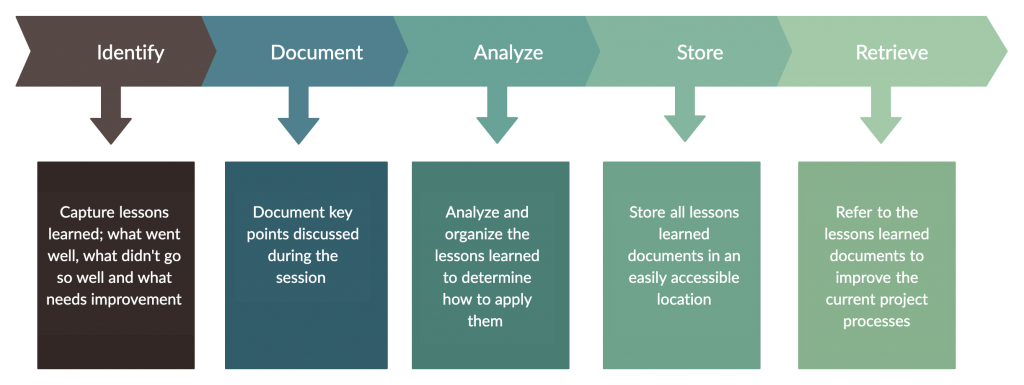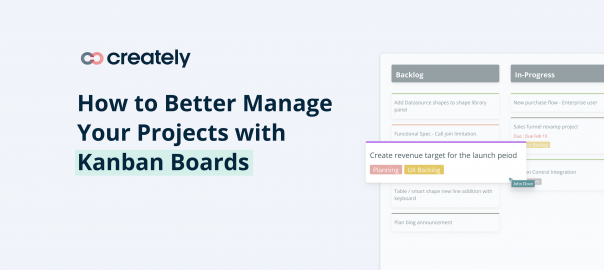Every project is a learning experience. Failures alert us to not make the same errors again. Successes guide us to effectively navigate our current and future projects. A proper process in place for capturing these failures, wins, and areas for improvement are necessary for successful project management. This is what the project lessons learned method does.
In this post, we’ll explore how to avoid project failures effectively using lessons learned. The templates provided throughout the post are editable online. Use them to get a move on with your tasks.
What are Project Lessons Learned?
Lessons learned are the key – both positive and negative – experiences collected throughout the lifecycle of a project as well as at its conclusion. Reflecting on this knowledge and understanding, you can convert what’s learned into actions needed to improve the current systems and processes and secure the success of future projects.
For some organizations, lessons learned in project management is an informal process where they discuss and document project experiences during the closure phase. Other organizations conduct a lesson learned session at the end of each phase of a project. Project managers, project team members as well as team leaders can participate in the lessons learned session to review the reports and make the decisions on how to convert the gained insight into actions.
Lessons learned sessions can be conducted at different phases of the project based on its complexity; at the end of each phase, at the conclusion of the project, or in real-time as it happens.
Why lessons learned should be an integral part of project management
Having the lessons learned documented and shared across the organization helps avoid and reduce the chances of failure. It also helps create best practices that can be incorporated into future endeavors.
Conducting lessons learned sessions also help with building trust among the team members; allowing them to share their own perspective on what went right and wrong during the project will let them feel more involved and encourage them to be more supportive of the project management process.
Ultimately, lessons learned can have a real impact on the company processes and the way the teams operate.
The lessons learned process
The lessons learned process includes five steps. They are aimed at gleaning important lessons learned during the project from the participants of the meeting, and at determining how to successfully apply that knowledge into achieving better results with future projects. The steps are,

Step 1: Identify the lessons learned
Start by revising what went well and what didn’t go so well during the project you’ve just completed and what needs to be improved. This should be done during the lessons learned session participated by the key stakeholders of the project. They can use lesson learned template for this task.
- In preparation for the session, the facilitator should send the participants a survey. It should include specific questions related to the different aspects of the project (i.e. project management, resources, communication, requirements, etc.). Equally important is to obtain their feedback on what worked, what didn’t work, and what should be improved in it. Answering the survey will not only help the participants better prepare themselves for the session, but the answers themselves will help guide the discussion between them.
- Summarize the survey results and analyze them along with other key reports during the session to identify project failures and wins. Recommendations for future project improvements should be discerned by the end of it.
You can use a similar chart like the one below to record the feedback and key points discussed during the session.

Step 2: Document the lessons learned
The next step of the process is to document the results with a detailed report. It should include the participant’s feedback on the strengths and weaknesses of the project and recommendations for improvement.
Once the report is complete, share it with the relevant internal and external project stakeholders. While you can create an overview of the detailed report for the leadership, the extensive report can be sent as an attachment for further reference.
Step 3: Analyze the lessons learned
During this phase of the process, analyze and organize the lessons learned in order to determine how to apply them. The required training for employees and improvements to project management processes are then decided.
As a further step, you can create an action plan using Creately action plan template outlining the necessary steps, responsible parties/ departments, resources, and a timeline.

Step 4: Archive the lessons learned
Store all lessons learned documents in an easily accessible location, like in a shared drive (i.e. Google Drive), making it readily available to the project team as well as other teams in the organization and stakeholders.
Step 5: Retrieve the lessons learned
Refer to the lessons learned documents to improve the current project processes. Optimize the retrievability of these documents by creating folders for each type of project and properly organizing them by date or project name. If the tool you use to store the reports offer keyword search capability, it would be much easier for anyone to retrieve them.
How to Avoid Project Failures with Lessons Learned
Here are a few steps you can incorporate into your project lessons learned process to ensure project success.
Conduct lessons learned sessions frequently
Many things can go wrong or right in a project, especially if it is a large complex initiative. Therefore it would serve well to record key information sooner rather than waiting till the end of the project. As time elapses you might fail to retain key insight or in the case of a non-success, information may get intentionally looked over.
Have a standard process and set of tools
Many organizations often fail to capture lessons learned during projects because they lack a defined process.
A proper set of steps in place makes it seem more requisite and can aid the team to fall into a routine of recording the lessons learned during the projects. Similarly, having a predefined set of tools to use for gathering the information, storing the reports and documents, and sharing them across the organization, will further help streamline the process.
Make use of lessons learned during risk planning
During the risk assessment of a new project, refer to the past lessons learned reports of relevant projects to identify potential risks easily. Subsequently, you can move on to developing mitigation strategies.
Have a lessons-learned team
You can apply the lessons learned method – or actively record experiences, insight, and impressions in real-time – throughout the project. Clarify how you will be applying the method and select a team to take part in and take on an active role.
A best practice is to include members from different areas of the project so as to collect diverse perspectives. Keep the number of team members between 3 to 10.
Maintaining such a logbook of project experiences thus will help run more effective lesson learned sessions.

How Would You Use Lessons Learned in Project Management?
We have defined what are lessons learned in project management, the lessons learned process, and how to effectively apply the method to avoid project failure along with useful templates in this post.
Ensure that capturing, analyzing, and learning from lessons learned is part of every project you do. Equally important is to plan for the next set of steps to effectively apply the lessons learned. This continuous effort will help cultivate a culture of ongoing improvement within your organization.





Hi Amanda, I love this idea! Lessons learned are huge and should be identified so they won’t happen again unless they were lessons to benefit you or others. Analyzing is key to this in project management as you have pointed out. One cannot make recommendations with problems/successes. Excellent points!